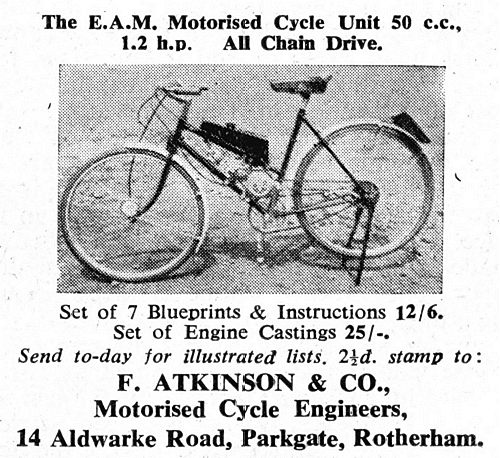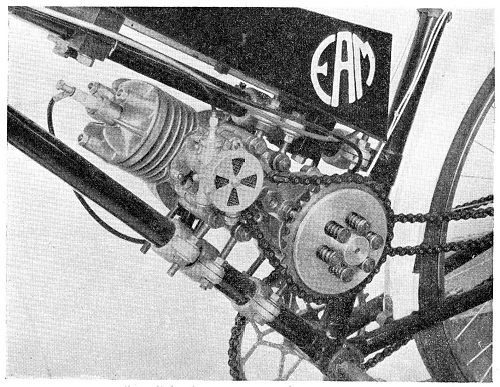 Go
to the Archive index
Go
to the Archive indexFifty years ago, model engineering was a much more widespread hobby than it is today and, with the lack of consumer products in that Age of Austerity, thrifty people with home workshops were ready and able to make their own labour saving devices like fridges, washing machines, and even ciné cameras and cyclemotors. To cater for the latter market, enterprising individuals designed and marketed cyclemotor kits for home production. The first was Dick Ostler's 'Mini Auto', which came on the market as a kit of parts in 1948. Better known was Edgar Westbury's 'Busy Bee', described in Model Engineer in the very early fifties, and available as a set of castings from Braid Bros, remaining on the market until at least the early 1960s.
Some years ago, a fellow enthusiast mentioned having once seen a publicity brochure for another, previously undocumented 'build at home' cyclemotor. Nobody else to whom I mentioned it had heard of it so I set out to try to find out if this engine really had existed, but instead of finding what I was looking for, discovered the existence of yet another, forgotten build-it yourself engine, variously known as the 'EAM' or the 'Atkinson'.
The initial discovery was made in the pages of Mechanics, a now barely remembered weekly magazine described as being 'for engineers and craftsmen' and encompassing engineering, do-it-yourself and model engineering. There, in the September 8th 1950 issue, was an advert from "motorised cycle engineers" F. Atkinson & Co., of 14, Aldwarke Road, Parkgate, Rotherham. A whole string of advertisements and short paragraphs in other copies of Mechanics, and Model Engineer enabled me to piece together something of the story of the EAM. As the Cyclemaster was described as the "Magic Wheel that Wings your Heel", so the EAM was heralded as the "Out of the Rut Motorised Cycle Unit". 3

The advertisement from Mechanics, 8 September 1950
Described as being specially designed for construction by model engineers, the EAM was a nominal 50cc [also listed as 47cc, but probably nearer 43cc] two-stroke, with a bore and stroke of 1½" (38.1mm), a flat topped piston, with a chain driven ball-bearing countershaft incorporating a handlebar-operated plate clutch, driving the rear wheel by a second chain to a sprocket on the opposite side of the wheel to the pedalling sprocket. It was stated to be 1.2hp, and capable, so its makers claimed, of 20-25mph and 240mpg. It used our old friends the Wico Pacy Bantamag and the Amal Micro Carburettor or 308 to you and me. A set of six blueprints cost 13/6; a set of engine castings, 25/-; the Bantamag, complete with contact breaker cam and crankshaft blueprint, cost £3/10/-; the carburettor, £1/12/-; finish machined and ground liner, 18/-; and rings, 2/6. A cyclemotor for £8/1/-! The less skilled could buy a bench tested engine, less magneto and carburettor, for £6/10/-
Atkinsons advertised "If you are building a cycle attachment of your own design, remember, we stock all your requirements, piston rings, bearings, etc. We are at your service for pattern making, castings and machining. Send for latest lists".
Atkinsons had a stand at the August 1950 Model Engineer Exhibition at Westminster's New Horticultural Hall, where they felt confident enough to award a special prize, The F.W. Atkinson & Co Prize, won by F.G. Boler of Leatherhead for a four cylinder, 10cc spark ignition two-stroke petrol engine, intended for powering a model racing car, a popular hobby at the time. Among the Loan Exhibits at the same Exhibition was a complete EAM fitted to a cycle, built by one G. Goodyear, and fortunately illustrated in Model Engineer.
In December 1950, the following advertisement appeared in Model Engineer: "F.Atkinson & Co, we very much regret the inconvenience caused to the hundreds of Model Engineers, etc., who have sent us orders for our various products and are still awaiting delivery. The delay has been occasioned through circumstances over which we have no control, but the position should be considerably eased in the near future. During the course of the next few days, we hope to write to all our clients giving full details."
In January 1951, Atkinsons advertised a Mark II EAM, "single chain drive to three speed gear of your cycle, drawings and working instructions, 12/6. All goods sent C.O.D., we pay postage and C.O.D. charges." And there, as far as this writer is concerned, the trail goes cold.

G. Goodyear's EAM,
shown at the 1950 Model Engineer Exhibition,
and pictured in Model Engineer, 14 September 1950.
So, who were F.Atkinson & Co? I made a trip to Rotherham Reference Library, but no mention of them could be found in any of the local trade directories of the time. Perusal of the files of the local paper brought no luck, with no mention of Atkinsons at the Model Engineer Exhibition, or anywhere else. The librarian told me the Aldwarke Road area had been totally flattened and redeveloped years ago, but showed me a large scale Ordnance Survey map from the 'fifties. 14 Aldwarke Road had been a terraced house, in domestic occupation, next door to the Electra Palace Cinema. Further rummaging in the dungeons of the Library brought forth the 1950 electoral register, and the registered voters at No 14 were a Frank and a Florence Atkinson. So it seems that "F.Atkinson & Co" was a one man band, evoking mind's eye visions of Frank working into the night filing and fettling his sets of castings in a shed at the back of his house.
Based on the placing of advertisements that I have seen, it was a business venture that lasted from June 1950 to the beginning of 1951. Did that December 1950 advert herald the beginning of the end of the enterprise and did it cost Frank his 'shirt'? Will we ever know what "EAM" stands for? Do the last two letters stand for "Auxiliary Motor" or "Atkinson Motor"?
How many EAMs were marketed? While doing a listing of cyclemotors registered by the City of York, I came across an EAM, registered in the mid 'fifties, with a serial number in the low to mid two-hundreds, which gives some idea. So where are they now? Enquiries in Model Engineer a few years ago brought no response whatsoever, so if anyone out there has got an EAM, please tell us about it. If you have any drawings or literature on the EAM, I am sure Andrew would be glad to borrow them to make copies for the Club Library. Did anything on the EAM appear in other magazines such as The Model Mechanic or Model Maker?
And that other forgotten 'build at home' cyclemotor that led to the rediscovery of the EAM? Well, while researching the EAM, I found tantalising evidence to show that it almost certainly did exist, probably a 30cc two-stroke. Even more obscure than the EAM, its story will have to wait until research turns up more information...
First published, August 2003
Frank Atkinson's daughter, Angela, has kindly provided this postscript to the story of the EAM cyclemotor:
"I stumbled across it [this article] quite by accident and found it so interesting. You see - Frank Atkinson was my father, and I would have been four or five years old when he invented the cyclemotor. I can't shed much light on the engineering involved, I think that Dad may have set up this business with my grandfather, I seem to recall they did have some sort of joint venture. Dad used to tell the tale about going to work on this machine in the dark and completely confusing the local bobby as he passed by on what looked, for all the world, to be an old pushbike! This would have been very much Dad's project - he was a brilliant engineer, but sadly, was not a businessman. Dad was a Toolmaker by trade and he also repaired and restored clocks as a hobby. Sadly, he died three years ago, just short of his 84th birthday, he and Mum had moved to Cambridgeshire to be closer to me and his granddaughter. He had a lathe in his shed at the bottom of the garden, and was working on a scale model steam engine. The work was very fine, an engineer who saw it after Dad's death said the work was amazing and he would have been privileged to meet a man who could produce something of that caliber. My sister, Cheryl, has the parts stored at her home - we couldn't bear to part with them."
August 2006